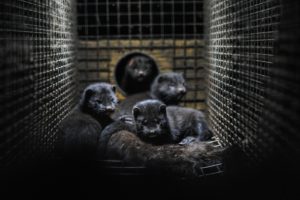Stop Fur Farming.

Mink kits at a fur farm cuddle to the body of their dead mother. Photo by Jo-Anne McArthur on Unsplash.
Fur farms: Where are they?
Across the globe approximately 100 million animals are bred and killed for their fur annually, including in Michigan. This includes 50.5 million in China, 37.8 million in Europe, 3.1 million in the U.S. and 1.8 million in Canada. Most of this fur is used in the fashion industry. It is estimated that the fur from about half of the animals killed goes to suppling fur trim for items like coats, hats, gloves and shoes.
It is difficult to know exactly how many fur farms there are in Michigan. This is because there is almost no regulatory oversight on fur farming in the state. The Michigan Department of Agriculture technically has the authority to regulate fur farms, but they do not. There are no special licenses required to operate a fur farm and there are no inspections to pass. The Michigan Department of Agriculture says that while they do not regulate fur farms they encourage fur farmers to follow the “voluntary industry codes of practice.” These voluntary guidelines are set by the pro-fur organization, Fur Commission USA.
Since there are no licenses required, there is no recorded data on how many fur farms currently operate in Michigan. Approximations from the USDA and independent surveys estimate there to be between nine and sixteen fur farms in Michigan.
Life on a Fur Farm
More than 95% of the fur sold every year comes from animals bred, raised and killed on fur farms. These animals spend their days in small, cramped wire cages, generally with several other animals. A typical fur farm mink cage measures between 1-1.5 feet in height, 8 inches to 1 foot wide and 2-3 feet deep. In the wild mink are highly active and have a home range of approximately 3-6 miles. Confined to these cages animals are unable to perform their basic natural behaviors. The inability to act naturally causes many animals to suffer from mental distress and exhibit stereotypies like pacing, repetitive circling and self-mutilation. While death may be a relief for animals living on a fur farm, this process is far from humane. In order to keep the pelts of these animals intact the most common methods for killing are gassing and electrocution.
Beyond the harm done to animals, fur farms are also a source of environmental devastation. The amount of manure accumulated on these farms is too much to decompose naturally and must be spread across large swaths of land in order to compost. The runoff from these manure fields greatly effects local air and water quality.
Buying Fur Free
Concerns over animal welfare have provoked many places to outright ban fur farming (The UK, Austria), phase out fur farming (Spain, Germany) or ban the import of fur (New Zealand, India). Similarly, many clothing designers and producers have committed to being fur free. Fur Free Alliance maintains a list of fur-free retailers here. You can contribute to the end of fur farming by refusing to buy fur products and supporting efforts to ban fur sales.
Fur Labels
In recent years the production of quality faux fur has become so good that it can often be hard to tell it apart from the real thing. Unfortunately, this difficult distinction coupled with some unscrupulous manufacturers means that sometimes people who think they are buying an item trimmed with faux fur are actually buying fur from a real animal.
Though there are laws on labelling animal fur in the U.S., an investigation by the Humane Society of the United States (HSUS) found that as many as 17 retailers were found to be selling items made with real fur while being labeled as faux. In laboratory tests, accessories that were said to be made with synthetic fur were determined to contain fur from animals like raccoons and rabbits. This false labeling violates the Fur Products Labelling Act, but stricter enforcement is needed.
Naturally, this is a disturbing discovery for anyone who wants to sure they are not contributing to the fur trade. Fortunately, there are a few ways consumers can try to distinguish real from faux fur short of a laboratory test. HSUS has put together a guide here. When in doubt the best bet is to avoid fur items altogether.



